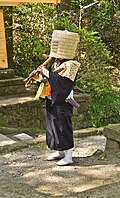 A Tozan school shakuhachi flute, blowing edge up. Left: top view, four holes. Right: bottom view, fifth hole. | |
| Woodwind instrument | |
|---|---|
| Classification | Woodwind |
| Hornbostel–Sachs classification | 421.111.12 (Open single end-blown flute with fingerholes) |
| Developed |
|
| Part of a series on |
| Komusō |
|---|
 |
| People |
|
| Philosophy |
| Places |
|
| Topics |
| Literature |
|
A shakuhachi (Japanese: 尺八, pronounced [ɕakɯhat͡ɕi]) is a Japanese longitudinal, end-blown flute that is made of bamboo. The bamboo end-blown flute now known as the shakuhachi was developed in Japan in the 16th century and is called the fuke shakuhachi (普化尺八).[1][2] A bamboo flute known as the kodai shakuhachi (古代尺八, ancient shakuhachi) or gagaku shakuhachi (雅楽尺八) was derived from the Chinese xiao in the Nara period and died out in the 10th century.[3] After a long blank period, the hitoyogiri shakuhachi (一節切尺八) appeared in the 15th century, and then in the 16th century, the fuke shakuhachi was developed in Japan. The fuke shakuhachi flourished in the 18th century during the Edo period, and eventually the hitoyogiri shakuhachi also died out. The fuke shakuhachi developed in Japan is longer and thicker than the kodai shakuhachi and has one finger hole less. It is longer and thicker than hitoyogiri shakuhachi and is superior in volume, range, scale and tone quality.[4] Today, since the shakuhachi generally refers only to fuke shakuhachi, the theory that the shakuhachi is an instrument unique to Japan is widely accepted.[5]
The shakuhachi is traditionally made of bamboo, but versions now exist in ABS, ebonite, anodized aluminum, and hardwoods. It was used by the monks of the Fuke Zen of Zen Buddhism in the practice of suizen (blowing meditation).
The instrument is tuned to the minor pentatonic scale.
- ^ Kotobank, Fuke shakuhachi. The Asahi Shimbun
- ^ Kotobank, Shakuhachi. The Asahi Shimbun
- ^ Kotobank, Kodai shakuhachi (Gagaku shakuhachi). The Asahi Shimbun
- ^ Kotobank, Hitoyogiri shakuhachi. The Asahi Shimbun
- ^ Tomiko Kojima. (2008) Japanese traditional performing arts course. Music. p.384. Tankosha. ISBN 978-4473034892